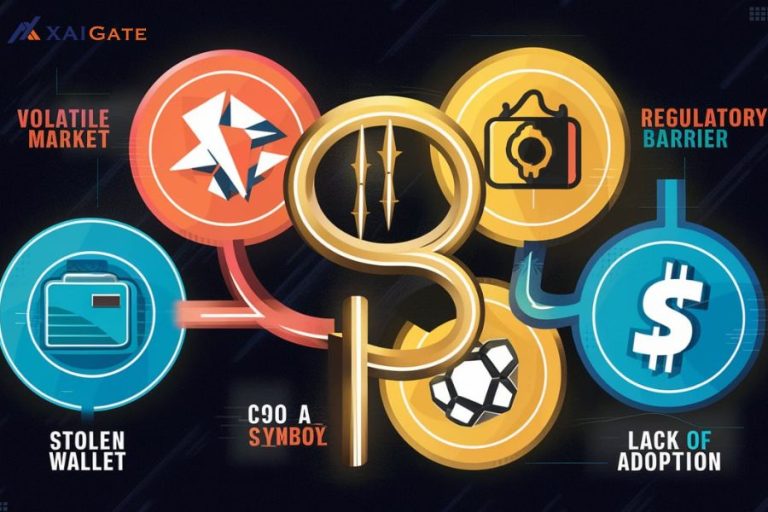As of 2024, over 10,000 cryptocurrencies exist, and this number keeps growing as companies constantly create new ones. “How many cryptocurrencies are there?” The exact count is hard to determine due to the dynamic nature of the market. While major players like Bitcoin and Ethereum dominate, there are thousands of lesser-known tokens, contributing to an ever-evolving and chaotic landscape of innovation. XAIGATE will compile 10 important cryptocurrencies other than Bitcoin through the article below.

Ethereum (ETH)
In 2015, a dude by the name of Vitalik Buterin launched Ethereum, a transparent as well as decentralized smart contracts’ production platform within blockchain and dApps execution. Thus the founder has positioned it number two among virtual currencies after Bitcoin due to own value held in circulation. While Bitcoin primarily functions as purely a digital currency, the blockchain of Ethereum was created so that transactions could take place programmatically as well as to enable creation and running of any software application without any interruptions due to malpractices or any other unexpected problems such as government regulation issues that may arise on traditional platforms like any third-party involvement in managing them. Its own coin called Ether (ETH) serves as means through which they may run applications, reward people who provide their resources in terms of computational power needed for such actions on this system or any related aspects.

Tether (USDT)
The stablecoin USDT, whose value is designed to be pegged at 1:1 against the US Dollar, is used in order to ensure that its value remains constant by being supported by the US Dollars put in reserve. Most people who trade on crypto markets usually use it is as well as those looking for a safe-haven asset during times when market prices are unpredictable. Given its stability; traders find tether very attractive since it offers protection from unpredictable price changes typical in other digital currencies.

XRP
The native cryptocurrency on the Ripple network is XRP. XRP is aimed at facilitating fast and low-cost international crypto payments, unlike conventional cryptocurrencies. It is intended to provide financial system solutions to cross-border transaction problems. In terms of transaction speed or energy consumption, it is much faster or less energy consuming than Bitcoin or Ethereum because of its unique consensus algorithm.
>>> Learn more: What is crypto payment gateway a guide

Binance Coin (BNB)
Binance Coin is the native digital currency for Binance exchange, one of the largest trading platforms globally. It was first launched on Ethereum before being moved to Binance’s blockchain network since then. For all network fees, it is essential to use BNB within the Binance ecosystem.

USD Coin (USDC)
USDC maintains a stable value by being pegged to the US dollar. People largely use it as a trading, lending, and safe haven asset in the digital currency markets when there is high volatility within prices. It is fully collateralized and run on multiple notable blockchains hence giving those who have confidence in it transparency and guarantees.

Cardano (ADA)
Charles Hoskinson is an Ethereum cofounder who made ADA by building Cardano- A blockchain platform that he created to establish secure infrastructure that allows scalability and decentralization while supporting smart contracts and applications development; this company was established in 2017 uses unique consensus algorithm known as Ouroboros from Greek mythology where snake eats its tail involves process called proof of stake algorithms. Cardano is different from other cryptocurrencies in that it emphasizes academic research and peer-reviewed development.

Solana (SOL)
Solana is a blockchain coin (SOL) that is high-performing notable for its agility and quick transaction processing in mind use by the low-cost digital coins and dApps. Launched in 2020, it operates on a novel means of reaching consensus – Proof of History (PoH) – which is aimed at enhancing its throughout by cutting down on confirmation time. Many people use Solana as a cryptocurrency because it can handle many transactions per second and has increasingly more decentralized applications.

Dogecoin (DOGE)
In 2013, Dogecoin (DOGE) was introduced as a joke cryptocurrency being motivated by the well known Shiba Inu meme which came from Japan. Nevertheless, its active community’s presence and being endorsed by prominent people such as Elon Musk have made it more popular than expected given such humble beginnings. It was made to function as funny replacement of other cryptocurrencies but because of this reason has achieved some level of significance within the wider context of digital money because people now use it often for rewarding or giving to charity.

In 2017, the decentralized internet and content ecosystem called Tron that was developed by Justin Sun, who has his founder, came of digital age using the blockchain; left parenthesis; Instead of but for the fact that it utilizes the process of quick transactions at minimum expense to content creators and programmers, this project concentrates on enabling quick trades; right parenthesis. Concert with TRX, its proprietary token or rather the coin, it is able to effect payments to different ends within the network thereby encouraging token holders into service provision.

Polygon (MATIC)
The creation of a multi-chain ecosystem is how the Polygon (MATIC) scaling system aids in fast tracking of payments while reducing their expenses and is known as Layer two on Ethereum. Such an innovative strategy will contribute towards tackling Ethereum’s performance-related challenges as well as enabling app developers to create more effective decentralized applications.

>>> Learn more: How Does Cryptocurrency Payment Gateway Work
Conclusion
Simply put “Ethereum Payment Gateway” is the key to appreciating an ever-changing scenario that is the digital currency market. The list of possible options keeps growing with approximately 10,000 being already reported- the figure is just about any. The continuously innovating and expanding nature of the currency market with its mix of benefits and downsides for traders and creators trying to survive in this intricate ecosystem is what this variable environment mirrors.
XAIGATE is a secure and user-friendly crypto payment gateway that allows businesses to accept cryptocurrency payments from customers around the world. With How To Accept Crypto Payments with WordPress, businesses can easily integrate cryptocurrency payments into their existing websites or online stores.









How many cryptocurrencies are currently in circulation, and what factors contribute to the constant change in their number?
As of today, there are thousands of cryptocurrencies in circulation, with the number constantly changing due to the dynamic nature of the cryptocurrency market. Currently, there are over 20,000 cryptocurrencies, according to various cryptocurrency tracking websites like CoinMarketCap and CoinGecko. However, not all of these coins or tokens are actively traded or hold significant value.
Key Factors Contributing to the Constant Change in Cryptocurrency Numbers:
1. New Cryptocurrencies Being Launched
New cryptocurrencies are constantly being created. Entrepreneurs and developers launch new tokens and coins for various purposes, such as to fund projects through Initial Coin Offerings (ICOs), or to introduce innovative features within the blockchain space. These new cryptocurrencies can be launched with unique features or as forks of existing coins, leading to an increase in their number.
2. Blockchain Projects and Tokenization
Many blockchain projects involve tokenization, where businesses or platforms create their own tokens to represent assets, stakes, or services. These tokens may not necessarily be independent cryptocurrencies but contribute to the overall increase in the total number of digital currencies.
3. Market Sentiment and Trends
The popularity of certain types of projects, such as DeFi (Decentralized Finance), NFTs (Non-Fungible Tokens), or Web3, can lead to the creation of new cryptocurrencies that cater to specific trends or market needs. For instance, a surge in interest for NFTs led to the rise of many NFT-related tokens, adding to the growing list of cryptocurrencies.
4. Forks of Existing Cryptocurrencies
A “fork” is when a cryptocurrency’s underlying code is modified to create a new version. These forks can either be soft forks (backward-compatible) or hard forks (completely separate). Popular cryptocurrencies like Bitcoin and Ethereum have seen multiple forks, creating new coins like Bitcoin Cash, Litecoin, and Ethereum Classic, which contribute to the total count of cryptocurrencies.
5. Shutting Down of Cryptocurrencies
While new cryptocurrencies are frequently launched, many also disappear. This can happen for various reasons, including a lack of adoption, project failure, or regulatory issues. Dead coins or tokens no longer maintain value and are often delisted from exchanges, reducing the overall number of active cryptocurrencies.
6. Regulation and Legal Issues
Governments around the world are becoming increasingly involved in regulating cryptocurrencies. Regulatory challenges and legal hurdles can lead to the removal or suspension of certain coins or tokens from the market, especially if they violate securities laws or other regulations.
7. Evolving Use Cases
As blockchain technology evolves, the use cases for cryptocurrencies expand. Cryptocurrencies are no longer limited to being a store of value or a medium of exchange. New types of coins and tokens are being created to serve as governance tokens, stablecoins, privacy coins, or to fulfill specific needs within decentralized applications (dApps), further increasing the total number.
Conclusion:
The number of cryptocurrencies is always in flux, with thousands of digital currencies being actively traded today. As new projects are launched, and others are abandoned or merged, the landscape of cryptocurrency continues to grow and evolve. The combination of technological innovation, market demand, and regulatory factors will continue to shape the number and diversity of cryptocurrencies in the coming years.
How many cryptocurrencies are currently in existence, and how are they classified?
The cryptocurrency market is vast and rapidly evolving, with new cryptocurrencies being created regularly. As of now, there are over 22,000 cryptocurrencies in existence. However, this number can fluctuate as new projects launch, while others fade away or are abandoned. The sheer variety of cryptocurrencies can be overwhelming, but they are generally classified into a few broad categories:
1. Major Cryptocurrencies
These are the most well-known and widely adopted cryptocurrencies, including Bitcoin (BTC), Ethereum (ETH), and Binance Coin (BNB). These coins typically have large market capitalizations and strong community support.
Example: Bitcoin (BTC) is often referred to as “digital gold” and remains the most valuable cryptocurrency by market capitalization.
2. Altcoins
Altcoins refer to all cryptocurrencies other than Bitcoin. Some of the most popular altcoins include Litecoin (LTC), Ripple (XRP), Cardano (ADA), and Polkadot (DOT). Altcoins can offer unique features and solutions that differ from Bitcoin, such as faster transaction times or more advanced smart contract capabilities.
Example: Ethereum (ETH) is a prominent altcoin that supports smart contracts, enabling decentralized applications (DApps) to be built on its blockchain.
3. Stablecoins
Stablecoins are cryptocurrencies designed to maintain a stable value by being pegged to an underlying asset like a fiat currency (e.g., the U.S. dollar) or commodities (e.g., gold). The idea is to reduce the volatility typically seen in cryptocurrencies.
Example: Tether (USDT) is a widely used stablecoin pegged to the U.S. dollar, offering more stability in transactions.
4. Tokens
Tokens are a type of cryptocurrency that represent assets or utilities within a specific ecosystem. They can be used for a wide range of purposes, including governance, staking, or accessing services within decentralized platforms (DeFi). Many tokens are built on top of existing blockchain networks like Ethereum or Binance Smart Chain (BSC).
Example: Uniswap (UNI) is a governance token for the Uniswap decentralized exchange platform, allowing holders to vote on protocol changes.
5. Privacy Coins
Privacy coins focus on enhancing the privacy and anonymity of transactions. They use advanced cryptographic techniques to obfuscate transaction details, offering greater privacy compared to more transparent blockchains like Bitcoin.
Example: Monero (XMR) is a privacy-focused cryptocurrency that ensures transactions are private and untraceable.
6. NFTs (Non-Fungible Tokens)
While technically a unique form of token, NFTs have gained popularity as digital collectibles, representing ownership of unique items or assets on a blockchain. NFTs are often used in gaming, art, music, and virtual real estate.
Example: CryptoPunks and Bored Ape Yacht Club are well-known NFT collections representing digital art and exclusive memberships.
7. DeFi Coins
DeFi (Decentralized Finance) coins are cryptocurrencies used within decentralized finance platforms that aim to replicate traditional financial services without intermediaries. These coins often enable users to lend, borrow, or trade assets in a decentralized manner.
Example: Aave (AAVE) is a DeFi token used within the Aave platform for decentralized lending and borrowing.
Conclusion:
The number of cryptocurrencies continues to grow as blockchain technology evolves and more use cases for digital currencies emerge. While Bitcoin remains the leader in the space, Ethereum and a wide variety of altcoins, stablecoins, tokens, and privacy coins provide a diverse and dynamic cryptocurrency ecosystem. The market is constantly changing, and understanding the different categories can help businesses and investors navigate the complexities of the cryptocurrency world.
At XAIGATE, we help businesses integrate cryptocurrency payment gateways that support a wide range of cryptocurrencies, enabling them to accept payments in any of the leading or emerging digital currencies. This gives businesses access to the full spectrum of the cryptocurrency market while maintaining secure and efficient payment processing.